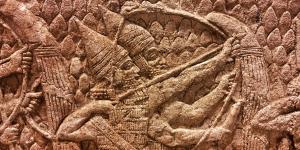You are here
Book of Mormon Central is in the process of migrating to our new Scripture Central website.
We ask for your patience during this transition. Over the coming weeks, all pages of bookofmormoncentral.org will be redirected to their corresponding page on scripturecentral.org, resulting in minimal disruption.
Gospel Doctrine Lesson #4: The Things Which I Saw While I Was Carried Away in the Spirit

Scripture Block
1 Nephi 12-14
To help class members understand Nephi’s vision of the future and how the warnings and promises in it apply to us today.
Lesson Manual
KnoWhys

What Plain and Precious Doctrines Were Lost?
1 Nephi 13:26

Are There Really Only Two Churches?
1 Nephi 14:10

How Did God Call His Prophets in Ancient Times?
1 Nephi 15:8
Articles
Nephi's Vision
Chart 92: "A Comparison of Lehi's Dream and Nephi's Vision," from Charting the Book of Mormon
At the end of 1 Nephi 14, Nephi bore record that he had seen "the things which my father saw," but Nephi's vision in 1 Nephi 11-14 does not appear at first glance to align well with Lehi's dream and revelations in 1 Nephi 8-10. However, this convenient chart shows over thirty elements that are surprisingly comparable in both passages. Viewing these two texts together yields new insights concerning the meanings of the Tree of Life and the future of Lehi's posterity.
"Lehi's Dream and Nephi's Vision as Apocalyptic Literature,"(link is external) by Jared M. Halversen, from The Things Which My Father Saw: Approaches to Lehi's Dream and Nephi's Vision(link is external)
The use of a narrative history like that of Nephi’s vision is one of the distinguishing features of the apocalyptic genre. The wordapocalypse comes from the Greek noun apokalypsis, meaning “revelation” or “disclosure,” and what is usually being revealed is the hand of God in the events of history, especially during times when history does not appear to be going God’s way. During such periods, the focus of scripture becomes increasingly eschatological, in hopes that today’s trials will be eclipsed by hope for tomorrow.
"Nephi's Vision and the Loss and Restoration of Plain and Precious Truths,"(link is external) by Lori Driggs, from The Things Which My Father Saw: Approaches to Lehi's Dream and Nephi's Vision(link is external)
In the great vision of the ancient American prophet Nephi, he describes the coming forth of a record of the Jews, the Bible, which contains “the covenants of the Lord” and “many of the prophecies of the holy prophets” (1 Nephi 13:23). Of this book Nephi declares, “When it proceeded forth from the mouth of a Jew it contained the fulness of the gospel of the Lord,” but “there are many plain and precious things taken away from the book” (vv. 24, 28). How were the plain and precious truths lost from the Bible? What factors may have influenced or brought about the loss of these truths? Which plain and precious truths were brought forth to us again through the record of Nephi? This study will examine (1) factors that may have caused truth to be lost from the Bible, (2) truths Nephi considered plain and precious enough to include in the Book of Mormon, and (3) the significance of the loss and restoration of plain and precious truth for us today. Much of the discussion regarding the Bible will center on the texts of the New Testament, focusing on textual changes made before approximately fifth century AD.
"Lehi's Dream as a Template for Understanding Each Act of Nephi's Vision,"(link is external) by Amy Easton-Flake, from The Things Which My Father Saw: Approaches to Lehi's Dream and Nephi's Vision(link is external)
A literary analysis of Lehi’s dream and Nephi’s vision makes clear the sincerity with which Nephi penned the words, “I bear record that I saw the things which my father saw, and the angel of the Lord did make them known unto me” (1 Nephi 14:29). By paying close attention to the established narrative logic, the repetition, overlapping, conjoining of words and images, and Nephi’s role in the retelling process, we recognize that although Nephi did not experience the elements in the same manner as his father did (Nephi’s vision was collective and historic, while his father’s was intimate and symbolic), he did see the same symbols and comprehend how his father’s dream acted as a template for understanding the future of his posterity, the Gentile inhabitants of the New World, and all people before Christ’s Second Coming. He then sought to make these connections known to his reader in his reconstruction of his vision.
"'Delivered by the Power of God': Nephi's Vision of America's Birth,"(link is external) by Kenneth L. Alford, from The Things Which My Father Saw: Approaches to Lehi's Dream and Nephi's Vision(link is external)
In contrast to Lehi’s tree of life vision, which is not tied to specific historical events, Nephi’s vision in 1 Nephi 11–14 is brimming with historical details, references, and prophetic insights. In 1 Nephi 13, Nephi was probably shown the successful struggle surrounding the birth of the United States and the fact that the Lord would use his power to influence the outcome.
"What Nephi's Vision Teaches about the Bible and the Book of Mormon,"(link is external) by Kenneth L. Alford, from The Things Which My Father Saw: Approaches to Lehi's Dream and Nephi's Vision(link is external)
Both the process and the content of the revelation in Nephi’s vision help the reader understand many things about the scriptures. Nephi’s vision makes numerous references to the Bible (i.e., the book that would proceed forth out of the mouth of a Jew) as well as to the Book of Mormon (i.e., the record of the seed of Nephi). These important teachings fall into three basic categories. First, Nephi’s vision mentions elements of stories found in the Bible and acts as a confirming witness that the Bible is true. Second, Nephi’s vision provides essential details that shed light on the nature of the Bible and the process by which it was transmitted over the centuries. Third, Nephi’s vision teaches important truths concerning the role of the Bible and the Book of Mormon in the restoration of the gospel. Book of Mormon writers repeatedly testified that they wrote for future generations under the inspiration of God (see 1 Nephi 6:3–6; 19:6; 2 Nephi 33:10–15; Jacob 7:27; Mormon 8:35; Mormon 9:30–31; and Ether 8:26). It is therefore vital that Latter-day Saints understand what Nephi’s vision teaches about the witness of the Bible, the nature of the Bible, and the role of both the Bible and Book of Mormon in the latter days.
"'Zion' and 'Jerusalem' as Lady Wisdom in Moses 7 and Nephi's Tree of Life Vision,"(link is external) by Samuel Zinner, from Interpreter: A Journal of Mormon Scripture(link is external)
When the angel tells Nephi to behold the love of God, Nephi sees a vision of the virgin Mary. Samuel Zinner explores the idea of the divine feminine by comparing Jewish treatment of "Zion" and "Jerusalem" throughout Hebrew scripture, as well as by drawing connections with other Middle Eastern traditions of the divine feminine.
"'Behold, I Have Dreamed a Dream',"(link is external) by Susan Easton Black, from The Book of Mormon: First Nephi, The Doctrinal Foundation(link is external)
Susan Easton Black provides a detailed commentary on Lehi's vision of the tree of life, paying special attention to the theme of "seeds," both agricultural and familial. Prior to Lehi's vision, he seems to be preoccupied with gathering seeds and grain for their sojourn in the wilderness, as well as preoccupied with the welfare of his own seed: his children. The vision of the Tree of Life answers Lehi's potential worries about his seed. The love of God and adherence to the commandments of God promises eternal life and salvation to all of his family members who will partake.
"The Plain and Precious Parts,"(link is external) by John W. Welch, from Reexploring the Book of Mormon(link is external)
This piece explores what it means when the angel taught Nephi about the "plain and precious parts" that would be excised from the gospel. John Welch elaborates that angel specifically outlined three ways in which this apostate process would take place. Welch then further discusses how the Book of Mormon restores those things that the angel prophesied would be lost.
"Connections Between the Visions of Lehi and Nephi,"(link is external) by John W. Welch, from Pressing Forward with the Book of Mormon(link is external)
John Welch first outlines and accounts for the seeming disparity between Lehi’s and Nephi's visions. Though the two visions are distinct, Welch seeks to show that the two visions are unified in essence and share many of the same elements. Nephi did indeed see the things which his father saw and more, as the angel guided him through the interpretation of the vision.


